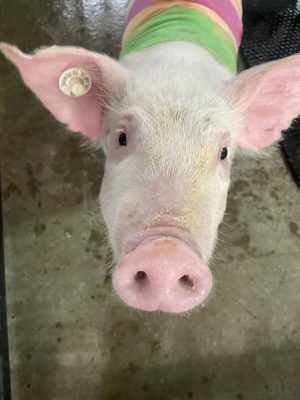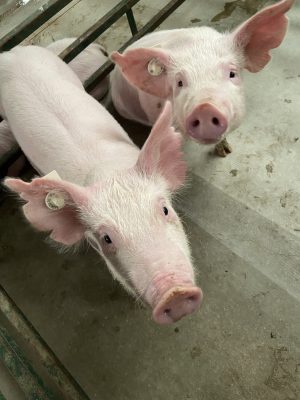For a person with diabetes, even a small, seemingly innocuous bedsore can lead to amputation.
Non-healing wounds disproportionately affect diabetics due to the decreased blood flow, chronic inflammation, and impaired healing processes associated with diabetes. If the wound is located on a foot or another peripheral region of the body, a diabetic person is at increased risk of amputation compared to non-diabetic peers.
In the U.S. more than 34 million people have diabetes and another 88 million are considered pre-diabetic. Yet currently there is just one FDA-approved treatment available for patients suffering from diabetic foot ulcers, a common type of non-healing wound. “Isn’t that crazy? There’s hardly anything to treat these wounds with,” comments Brenda Alexander, a professor in the UW Department of Animal Science.
She hopes to remedy this situation. In collaboration with Sreejayan Nair, a professor in UW’s School of Pharmacy, Alexander helped test a promising new treatment for diabetics suffering from non-healing wounds.
How it works
Non-healing wounds are associated with increased activity by proteases, enzymes that break down proteins.

Nair’s novel treatment relies on what’s known as a protease inhibitor. If a protease is inhibited, protein synthesis increases. “It’s a balance between breaking down proteins and synthesizing proteins,” Alexander explains. “What we are going for is an increase in protein synthesis.”
Specifically, the treatment is designed to increase production of collagen, a protein that facilitates wound repair. The idea is to inhibit a protease called cathepsin K to promote increased production of collagen and boost the healing process.
Previous studies have shown that increased cathepsin K and decreased collagen are associated with impaired wound healing in humans. Nair and Alexander’s latest study involved testing whether a protease inhibitor targeting cathepsin K would accelerate diabetic wound healing in pigs.
Why pigs?
The treatment was first tried in mice, with successful results. Accelerated wound healing was observed in diabetic mice genetically modified to eliminate cathepsin K.
The next step was to test the new treatment in a larger vertebrate animal with skin anatomy similar to that of humans. “You can make a mouse diabetic but the way they heal is different than the way a human heals,” Alexander explains.
The solution? Pigs. Unlike mice, whose skin contracts to heal a wound, pigs and humans form new skin via cell migration and proliferation across the wound.
As larger animals with greater skin surface, pigs also offer another experimental advantage: responses to multiple treatments, including the control, can be compared using the skin of the same individual. This both reduces the number of animals required for the study and strengthens experimental integrity.
The experiment
For their research, Alexander and Nair studied small groups of young Yorkshire pigs at the Laramie Research and Extension Center. To induce a diabetic state, the pigs were anesthetized and intravenously injected with a drug that kills the insulin-creating beta cells of the pancreas.

Within 24 to 48 hours of the injection, the pigs were considered diabetic, meaning they have higher than normal blood glucose levels and experienced disease processes similar to humans with diabetes. The pigs were monitored to ensure that their glucose levels were not so high that they couldn’t gain weight at an acceptable rate.
After a month with elevated blood glucose levels, the pigs received surgical wounds, which were promptly treated and dressed. To mitigate pain, they were also treated with opioid patches. Researchers tended to the animals every day, ensuring a high level of cleanliness and allowing for careful documentation of wound healing.
Treatments included the one drug currently available for treatment of diabetic foot ulcers as well as different dosages and application methods (gel versus injection, for example) of the novel drug.
Healing was measured by wound size and appearance (documented with photos) as well as by tissue samples taken after the animal was euthanized. The researchers also performed toxicology analyses to ensure the treatment didn’t cause harmful side effects to other tissues and bodily systems.
Promising results
The investigation is ongoing, but so far the results are promising. The diabetic pigs’ wounds consistently healed better and faster with the new treatment, Alexander reports.
Not only did the novel treatment accelerate healing compared to the control, but it also outperformed the only drug currently available on the market. The toxicology results did not indicate any potential harmful side effects. Together, these findings make the new treatment a strong candidate to be approved for future clinical trials.
Alexander notes that the study’s success would not be possible without the pig studies conducted at the Laramie Research and Extension Center. “I think it is important to recognize that these agriculture animals are playing a really important role in research and potentially benefiting many people,” she comments.
Interdisciplinary collaboration is also key. Though Alexander modestly insists that she’s “just the pig person,” it is the combination of her animal science expertise and Nair’s pharmaceutical ingenuity that made the study feasible. “Dr. Nair’s work is really important, and he made contact with me to be able to expand his research and expand the good to the whole population,” says Alexander.
To learn more, contact Alexander at balex@uwyo.edu or (307) 766-6278.
This article was originally published in the 2023 issue of Reflections, the annual research magazine of the UW College of Agriculture, Life Sciences and Natural Resources.




